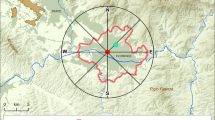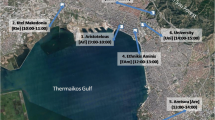Abstract
Phenological studies in combination with aerobiological studies enable one to observe the relationship between the release of pollen and its presence in the atmosphere. To obtain a suitable comparison between the daily variation of airborne pollen concentrations and flowering, it is necessary for the level of accuracy of both sets of data to be as similar as possible. To analyse the correlation between locally observed flowering data and pollen counts in pollen traps in order to set pollen information forecasts, pollen was sampled using a Burkard volumetric pollen trap working continuously from May 1993. For the phenological study we selected the main pollen sources of the six pollen types most abundant in our area: Cupressaceae, Platanus, Quercus, Plantago, Olea, and Poaceae with a total of 35 species. We selected seven sites to register flowering or pollination, two with semi-natural vegetation, the rest being urban sites. The sites were visited weekly from March to June in 2007, and from January to June in 2008 and 2009. Pollen shedding was checked at each visit, and recorded as the percentage of flowers or microsporangia in that state. There was an association between flowering phenology and airborne pollen records for some of the pollen types (Platanus, Quercus, Olea and Plantago). Nevertheless, for the other types (Cupressaceae and Poaceae) the flowering and airborne pollen peaks did not coincide, with up to 1 week difference in phase. Some arguments are put forward in explanation of this phenomenon. Phenological studies have shown that airborne pollen results from both local and distant sources, although the pollen peaks usually appear when local sources are shedding the greatest amounts of pollen. Resuspension phenomena are probably more important than long-distance transport in explaining the presence of airborne pollen outside the flowering period. This information could be used to improve pollen forecasts.









Similar content being viewed by others
References
Aboulaich N, Bouziane H, Kadiri M, Trigo MM, Riadi H, Kazzaz M, Merzouki A (2009) Pollen production in anemophilous species of the Poaceae family in Tetouan (NW Morocco). Aerobiologia 25:27–38
Domínguez E, Galán C, Villamandos F, Infante F (1992) Manejo y evaluación de los datos obtenidos en los muestreos aerobiológicos. Monografías REA/EAN 1:1–13
Estrella N, Menzel A, Krämer U, Behrendt H (2006) Integration of flowering dates in phenology and pollen counts in aerobiology: analysis of their spatial and temporal coherence in Germany (1992–1999). Int J Biometeorol 51:49–59
Fairley DJ, Batchelder GL (1986) A study of oak-pollen production and phenology in northern California: prediction of annual variation in pollen counts based on geographic and meteorological factors. J Allergy Clin Immunol 78:300–307
Fornaciari F, Orlandi F, Romano B (2000) Phenological and aeropalynological survey in an olive orchard in Umbria (Central Italy). Grana 39:246–251
García-Mozo H, Chuine I, Aira MJ, Belmonte J, Bermejo D, Díaz de la Guardia C, Elvira B, Gutiérrez M, Rodríguez-Rajo J, Ruiz L, Trigo MM, Tormo R, Valencia R, Galán C (2008) Regional phenological models for forecasting the start and peak of the Quercus pollen season in Spain. Agric Forest Meteorol 148:372–380
Gonzalo MA, Tormo R, Muñoz AF, Silva I (2006) Differences in the spatial distribution of airborne pollen concentrations at different urban locations within a city. J Investig Allergol Clin Immunol 216:37–43
Hidalgo PJ, Galán C, Domínguez E (2003) Male phenology of three species of Cupressus: correlation with airborne pollen. Trees 17:336–344
Hirst JM (1952) An automatic volumetric spore trap. Ann Appl Biol 39:257–265
Ickovic MR, Boussioud-Corbieres F, Sutra JP, Thibaudon M (1989) Hay fever symptoms compared to atmospheric pollen counts and floral phenology within Paris suburban area in 1987 and 1988. Aerobiologia 5:30–36
Jato V, Rodríguez-Rajo F, Méndez J, Aira M (2002) Phenological behaviour of Quercus in Ourense (NW Spain) and its relationship with the atmospheric pollen season. Int J Biometeorol 46:176–184
Jato V, Rodríguez-Rajo FJ, Aira MJ (2007a) Use of phenological and pollen-reproduction data for interpreting atmospheric birch pollen curves. Ann Agric Environ Med 14:271–280
Jato V, Rodríguez-Rajo FJ, Aira MJ (2007b) Use of Quercus ilex subsp. ballota phenological and pollen-production data for interpreting Quercus pollen curves. Aerobiologia 23:91–105
Kasprzyk I (2003) Flowering phenology and airborne pollen grains of chosen tree taxa in Rzeszów (SE Poland). Aerobiologia 19:113–120
Latorre F (1997) Comparison between phenological and aerobiological patterns of some arboreal species of Mar del Plata (Argentina). Aerobiologia 13:49–59
Latorre F (1999) Differences between airborne pollen and flowering phenology of urban trees with reference to production, dispersal and interannual climate variability. Aerobiologia 15:131–141
Lorenzoni FC, Giorato M, Marcer G (1998) Phenological and aerobiological monitoring of allergenic flora in padua (Italy). Preliminary data. Aerobiologia 14:285–289
Marcello A (1935) Nuovi criteri per osservazioni fito-fenologiche. Nuovo G Bot Ital 42:534–556
Orlandi F, Ruga L, Romano B, Fornaciari M (2005) An integrated use of aerobiological and phenological data to analyse flowering in olive groves. Grana 44:51–56
Prieto-Baena JC, Hidalgo PJ, Dominguez E, Galan C (2003) Pollen production in the Poaceae family. Grana 42:153–159
Ranta H, Kubin E, Siljamo P, Sofiev M, Linkosalo T, Oksanen A, Bondestam K (2006) Long distance pollen transport cause problems for determining the timing of birch pollen season in Fennoscandia by using phenological observations. Grana 45:297–304
Rivas-Martínez S (1987) Memoria del mapa de series de vegetación de España 1:400.000. ICONA, Ministerio de Agricultura, Pesca y Alimentación, Madrid
Roetzer T, Wittenzeller M, Haeckel H, Nekovar J (2000) Phenology in central Europe—differences and trends of spring phenophases in urban and rural areas. Int J Biometeorol 44:60–66
Rogers CA, Levetin E (1998) Evidence of long-distance transport of mountain cedar pollen into Tulsa, Oklahoma. Int J Biometeorol 42:65–72
Schwartz MD (1998) Advancing to full bloom: planning phenological research for the 21st century. Int J Biometeorol 41:113–118
Skjøth CA, Sommer J, Stach A, Smith M, Brandt J (2007) The long-range transport of birch (Betula) pollen from Poland and Germany causes significant pre-season concentrations in Denmark. Clin Exp Allergy 37:1204–1212
Water P, Levetin E (2001) The contribution of upwind pollen sources to the characterization of Juniperus ashei phenology. Grana 40:133–141
Water P, Keever T, Main CE, Levetin E (2003) An assessment of predictive forecasting of Juniperus ashei pollen movement in the Southern Great Plains, USA. Int J Biometeorol 48:74–82
Zanotti AL, Puppi G (2000) Phenological surveys of allergenic species in the neighbourhood of Bologna (Italy). Aerobiologia 16:199–206
Zerboni R, Manfredi M (1988) Utilization of aerobiological, phenological and phytogeographical data in allergology. Aerobiologia 4:27–32
Acknowledgement
This research project (PRI06A190) was subsidised financially by the Regional Government, Junta de Extremadura, Consejería de Infraestructuras y Desarrollo Tecnológico (Spain).
Author information
Authors and Affiliations
Corresponding author
Rights and permissions
About this article
Cite this article
Tormo, R., Silva, I., Gonzalo, Á. et al. Phenological records as a complement to aerobiological data. Int J Biometeorol 55, 51–65 (2011). https://doi.org/10.1007/s00484-010-0308-2
Received:
Revised:
Accepted:
Published:
Issue Date:
DOI: https://doi.org/10.1007/s00484-010-0308-2




